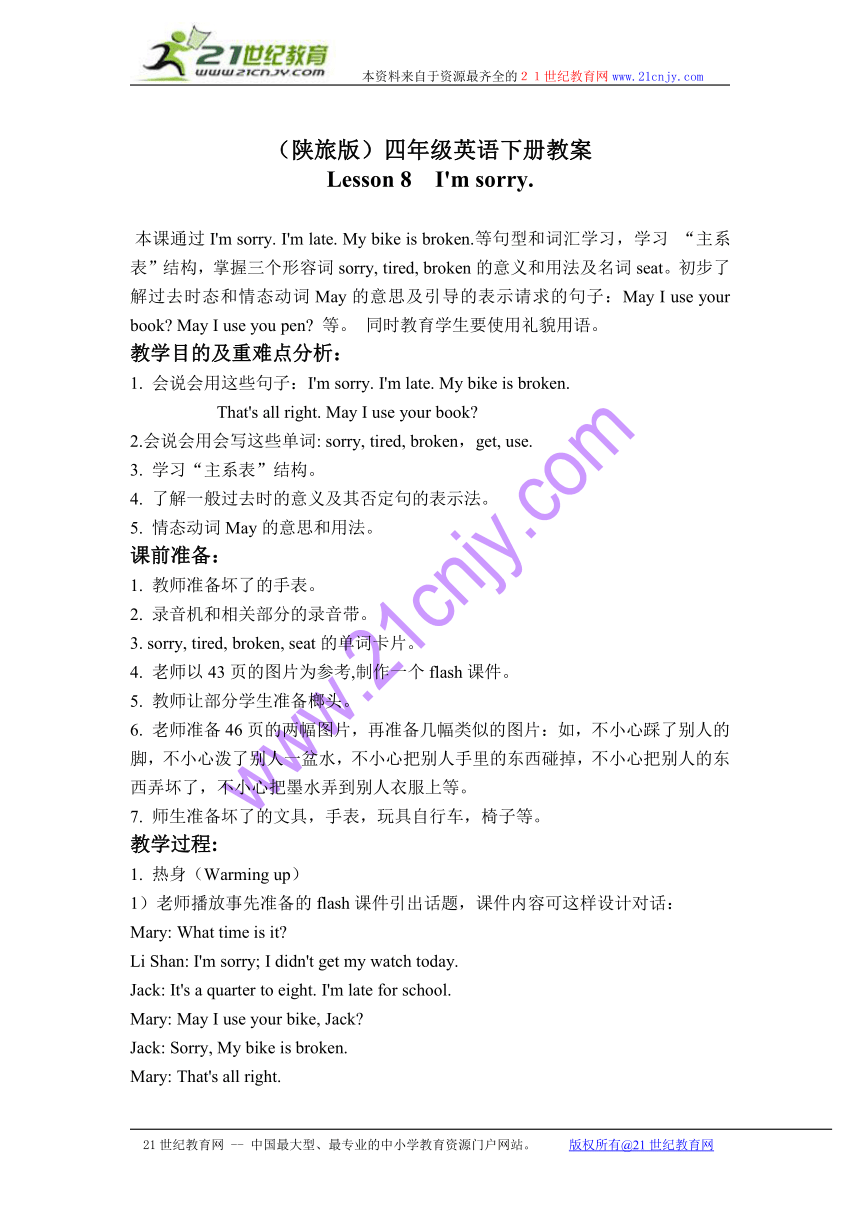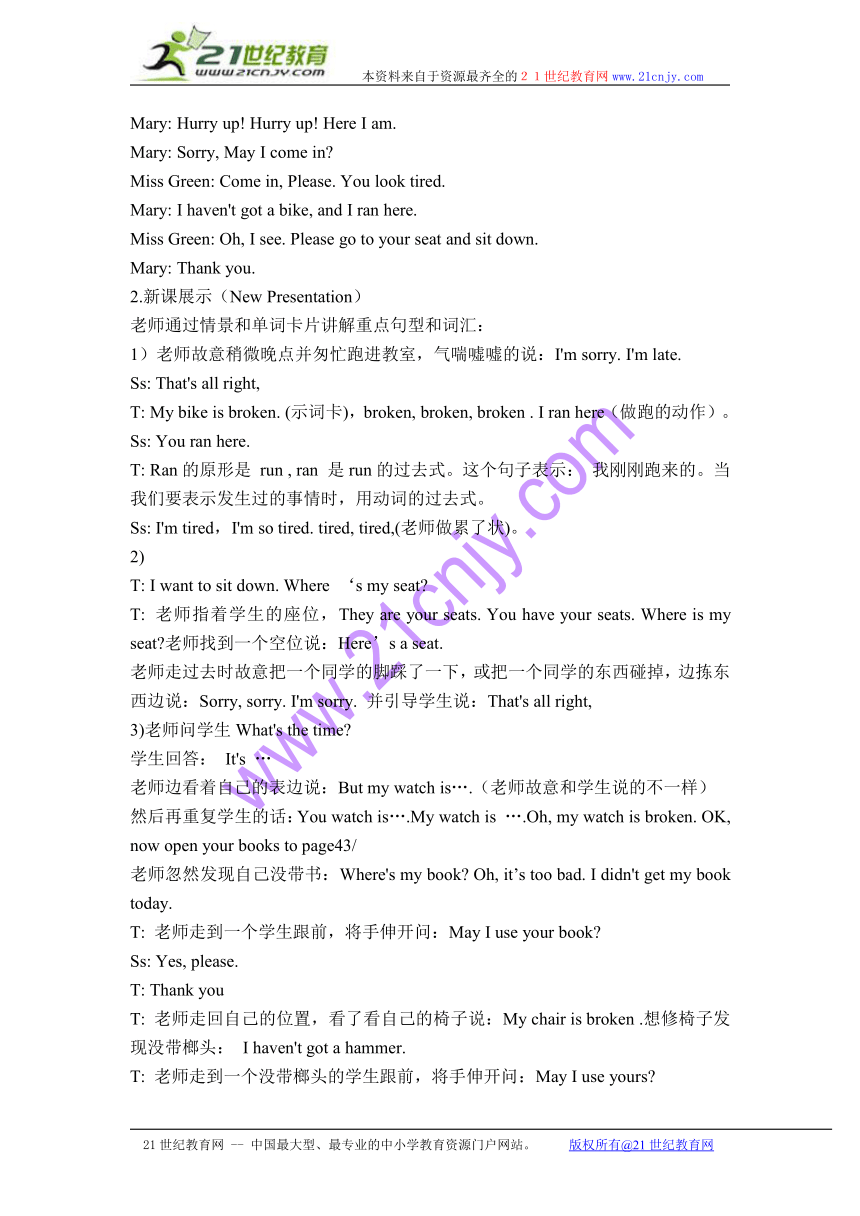四年级英语下册教案 lesson 8(1)(陕旅版)
文档属性
| 名称 | 四年级英语下册教案 lesson 8(1)(陕旅版) |  | |
| 格式 | rar | ||
| 文件大小 | 13.4KB | ||
| 资源类型 | 教案 | ||
| 版本资源 | 陕旅版 | ||
| 科目 | 英语 | ||
| 更新时间 | 2010-04-09 14:52:00 | ||
图片预览


文档简介
本资料来自于资源最齐全的21世纪教育网www.21cnjy.com
(陕旅版)四年级英语下册教案
Lesson 8 I'm sorry.
本课通过I'm sorry. I'm late. My bike is broken.等句型和词汇学习,学习 “主系表”结构,掌握三个形容词sorry, tired, broken的意义和用法及名词seat。初步了解过去时态和情态动词May的意思及引导的表示请求的句子:May I use your book May I use you pen 等。 同时教育学生要使用礼貌用语。
教学目的及重难点分析:
1. 会说会用这些句子:I'm sorry. I'm late. My bike is broken.
That's all right. May I use your book
2.会说会用会写这些单词: sorry, tired, broken,get, use.
3. 学习“主系表”结构。
4. 了解一般过去时的意义及其否定句的表示法。
5. 情态动词May的意思和用法。
课前准备:
1. 教师准备坏了的手表。
2. 录音机和相关部分的录音带。
3. sorry, tired, broken, seat的单词卡片。
4. 老师以43页的图片为参考,制作一个flash课件。
5. 教师让部分学生准备榔头。
6. 老师准备46页的两幅图片,再准备几幅类似的图片:如,不小心踩了别人的脚,不小心泼了别人一盆水,不小心把别人手里的东西碰掉,不小心把别人的东西弄坏了,不小心把墨水弄到别人衣服上等。
7. 师生准备坏了的文具,手表,玩具自行车,椅子等。
教学过程:
1. 热身(Warming up)
1)老师播放事先准备的flash课件引出话题,课件内容可这样设计对话:
Mary: What time is it
Li Shan: I'm sorry; I didn't get my watch today.
Jack: It's a quarter to eight. I'm late for school.
Mary: May I use your bike, Jack
Jack: Sorry, My bike is broken.
Mary: That's all right.
Mary: Hurry up! Hurry up! Here I am.
Mary: Sorry, May I come in
Miss Green: Come in, Please. You look tired.
Mary: I haven't got a bike, and I ran here.
Miss Green: Oh, I see. Please go to your seat and sit down.
Mary: Thank you.
2.新课展示(New Presentation)
老师通过情景和单词卡片讲解重点句型和词汇:
1)老师故意稍微晚点并匆忙跑进教室,气喘嘘嘘的说:I'm sorry. I'm late.
Ss: That's all right,
T: My bike is broken. (示词卡),broken, broken, broken . I ran here(做跑的动作)。
Ss: You ran here.
T: Ran的原形是 run , ran 是run的过去式。这个句子表示: 我刚刚跑来的。当我们要表示发生过的事情时,用动词的过去式。
Ss: I'm tired,I'm so tired. tired, tired,(老师做累了状)。
2)
T: I want to sit down. Where ‘s my seat
T: 老师指着学生的座位,They are your seats. You have your seats. Where is my seat 老师找到一个空位说:Here’s a seat.
老师走过去时故意把一个同学的脚踩了一下,或把一个同学的东西碰掉,边拣东西边说:Sorry, sorry. I'm sorry. 并引导学生说:That's all right,
3)老师问学生What's the time
学生回答: It's …
老师边看着自己的表边说:But my watch is….(老师故意和学生说的不一样)
然后再重复学生的话:You watch is….My watch is ….Oh, my watch is broken. OK, now open your books to page43/
老师忽然发现自己没带书:Where's my book Oh, it’s too bad. I didn't get my book today.
T: 老师走到一个学生跟前,将手伸开问:May I use your book
Ss: Yes, please.
T: Thank you
T: 老师走回自己的位置,看了看自己的椅子说:My chair is broken .想修椅子发现没带榔头: I haven't got a hammer.
T: 老师走到一个没带榔头的学生跟前,将手伸开问:May I use yours
Ss: Sorry, I didn't get my hammer today.
T: 老师走到一个学生跟前,将手伸开问:May I use yours
Ss: Yes, please.
T: Thank you!
4)老师修理了一下椅子说:I'm tired。然后老师故意指一个学生说:I'm tired. Can you help me 学生接过榔头干了几下:老师说:You look tired。
Look在这是“看起来”的意思,是系动词,后面可跟形容词,表示看起来怎么样。如: You look happy. He looks sad. These flowers look beautiful等等。
3.小结:
1)当我们说过去没做某事时,在这个动词前加did not 或 didn't ,这是过去式的否定式。例如:我刚才看电视了,I watched TV just now.你刚才没看电视。You didn't watch TV.今天小红没带英语书.Xiao Hong didn't get her English book today.
2)当我们要表示客气的向别人请求时,我们可以说:“May I …”,表示“我可以…吗?” 。回答通常用Yes, please.表肯定。 Sorry, you can't.表否定.
4.巩固活动;
1)角色扮演/情景再现
老师让学生两两一组,分别扮演老师和学生,演一个学生因为自行车坏了而上学迟到,老师让做到座位时匆忙中把别人的东西碰掉。老师让打开书时发现没带书的情景,评出今天的最佳语言奖和最佳表演奖。关键句如下:
I'm sorry. I'm late.
That's all right.
You look tired.
My bike is broken.
Go to your seat and sit down.
Sorry.
That's OK.
Oh, I didn't get my book today
May I use yours
5. 听录音学习对话:
T: Let's listen to a dialogue, then answer the questions.
(播放对话部分录音, 抢答,抢答正确者为所在的组赢得一分)
T: How many people are there in the dialogue
Ss: There are two people in the dialogue.
T: What are they
Ss: One is Miss Green. The other is a girl.
T: What ‘s the their relationship relationship 是关系。
Ss: They are teacher and student.
T: What’s wrong with the girl
Ss: Her bike is broken.
T: How did she come to school
Ss: She ran there.
T: Is she tired
Ss: Yes, She looks very tired.
6. 播放Listen ,look and match部分录音.
听并连线,看看哪个句子和哪幅图意匹配。
7.做Let's practice(I).通过理解致歉语启发学生掌握其应答短语。
这部分可设计成一个游戏,看谁是最懂礼貌的孩子。老师将事先准备的46页的两幅图片,和类似的图片:如,不小心踩了别人的脚,不小心泼了别人一盆水,不小心把别人手里的东西碰掉,不小心把别人的东西弄坏了,不小心把墨水弄到别人衣服上等分发给几个学生,让他们各自和同桌或周围的同学根据图片所示表演出来,看谁是最懂礼貌的孩子。
致歉:Sorry或I'm sorry.
应答:That's OK.或That's all right.
8. 做Let's Practice(II). 任务大赢家
老师让学生每人拿出一件事先准备好的坏了的文具,椅子,手表等;让学生根据实际情况完成对话,看谁最先找到自己需要的东西?谁就是今天的任务大赢家。并引导学生完成书上的对话部分。如:
S1: What's the time, S2
S2: I'm sorry. I didn’t get my watch today.
S1: That's OK.
学生1又走到另一个学生的面前说:I didn't get my watch today May I use yours
S3: Yes, Please.
Sorry, That's OK. Use, I’m sorry. didn't get
21世纪教育网 -- 中国最大型、最专业的中小学教育资源门户网站。 版权所有@21世纪教育网
(陕旅版)四年级英语下册教案
Lesson 8 I'm sorry.
本课通过I'm sorry. I'm late. My bike is broken.等句型和词汇学习,学习 “主系表”结构,掌握三个形容词sorry, tired, broken的意义和用法及名词seat。初步了解过去时态和情态动词May的意思及引导的表示请求的句子:May I use your book May I use you pen 等。 同时教育学生要使用礼貌用语。
教学目的及重难点分析:
1. 会说会用这些句子:I'm sorry. I'm late. My bike is broken.
That's all right. May I use your book
2.会说会用会写这些单词: sorry, tired, broken,get, use.
3. 学习“主系表”结构。
4. 了解一般过去时的意义及其否定句的表示法。
5. 情态动词May的意思和用法。
课前准备:
1. 教师准备坏了的手表。
2. 录音机和相关部分的录音带。
3. sorry, tired, broken, seat的单词卡片。
4. 老师以43页的图片为参考,制作一个flash课件。
5. 教师让部分学生准备榔头。
6. 老师准备46页的两幅图片,再准备几幅类似的图片:如,不小心踩了别人的脚,不小心泼了别人一盆水,不小心把别人手里的东西碰掉,不小心把别人的东西弄坏了,不小心把墨水弄到别人衣服上等。
7. 师生准备坏了的文具,手表,玩具自行车,椅子等。
教学过程:
1. 热身(Warming up)
1)老师播放事先准备的flash课件引出话题,课件内容可这样设计对话:
Mary: What time is it
Li Shan: I'm sorry; I didn't get my watch today.
Jack: It's a quarter to eight. I'm late for school.
Mary: May I use your bike, Jack
Jack: Sorry, My bike is broken.
Mary: That's all right.
Mary: Hurry up! Hurry up! Here I am.
Mary: Sorry, May I come in
Miss Green: Come in, Please. You look tired.
Mary: I haven't got a bike, and I ran here.
Miss Green: Oh, I see. Please go to your seat and sit down.
Mary: Thank you.
2.新课展示(New Presentation)
老师通过情景和单词卡片讲解重点句型和词汇:
1)老师故意稍微晚点并匆忙跑进教室,气喘嘘嘘的说:I'm sorry. I'm late.
Ss: That's all right,
T: My bike is broken. (示词卡),broken, broken, broken . I ran here(做跑的动作)。
Ss: You ran here.
T: Ran的原形是 run , ran 是run的过去式。这个句子表示: 我刚刚跑来的。当我们要表示发生过的事情时,用动词的过去式。
Ss: I'm tired,I'm so tired. tired, tired,(老师做累了状)。
2)
T: I want to sit down. Where ‘s my seat
T: 老师指着学生的座位,They are your seats. You have your seats. Where is my seat 老师找到一个空位说:Here’s a seat.
老师走过去时故意把一个同学的脚踩了一下,或把一个同学的东西碰掉,边拣东西边说:Sorry, sorry. I'm sorry. 并引导学生说:That's all right,
3)老师问学生What's the time
学生回答: It's …
老师边看着自己的表边说:But my watch is….(老师故意和学生说的不一样)
然后再重复学生的话:You watch is….My watch is ….Oh, my watch is broken. OK, now open your books to page43/
老师忽然发现自己没带书:Where's my book Oh, it’s too bad. I didn't get my book today.
T: 老师走到一个学生跟前,将手伸开问:May I use your book
Ss: Yes, please.
T: Thank you
T: 老师走回自己的位置,看了看自己的椅子说:My chair is broken .想修椅子发现没带榔头: I haven't got a hammer.
T: 老师走到一个没带榔头的学生跟前,将手伸开问:May I use yours
Ss: Sorry, I didn't get my hammer today.
T: 老师走到一个学生跟前,将手伸开问:May I use yours
Ss: Yes, please.
T: Thank you!
4)老师修理了一下椅子说:I'm tired。然后老师故意指一个学生说:I'm tired. Can you help me 学生接过榔头干了几下:老师说:You look tired。
Look在这是“看起来”的意思,是系动词,后面可跟形容词,表示看起来怎么样。如: You look happy. He looks sad. These flowers look beautiful等等。
3.小结:
1)当我们说过去没做某事时,在这个动词前加did not 或 didn't ,这是过去式的否定式。例如:我刚才看电视了,I watched TV just now.你刚才没看电视。You didn't watch TV.今天小红没带英语书.Xiao Hong didn't get her English book today.
2)当我们要表示客气的向别人请求时,我们可以说:“May I …”,表示“我可以…吗?” 。回答通常用Yes, please.表肯定。 Sorry, you can't.表否定.
4.巩固活动;
1)角色扮演/情景再现
老师让学生两两一组,分别扮演老师和学生,演一个学生因为自行车坏了而上学迟到,老师让做到座位时匆忙中把别人的东西碰掉。老师让打开书时发现没带书的情景,评出今天的最佳语言奖和最佳表演奖。关键句如下:
I'm sorry. I'm late.
That's all right.
You look tired.
My bike is broken.
Go to your seat and sit down.
Sorry.
That's OK.
Oh, I didn't get my book today
May I use yours
5. 听录音学习对话:
T: Let's listen to a dialogue, then answer the questions.
(播放对话部分录音, 抢答,抢答正确者为所在的组赢得一分)
T: How many people are there in the dialogue
Ss: There are two people in the dialogue.
T: What are they
Ss: One is Miss Green. The other is a girl.
T: What ‘s the their relationship relationship 是关系。
Ss: They are teacher and student.
T: What’s wrong with the girl
Ss: Her bike is broken.
T: How did she come to school
Ss: She ran there.
T: Is she tired
Ss: Yes, She looks very tired.
6. 播放Listen ,look and match部分录音.
听并连线,看看哪个句子和哪幅图意匹配。
7.做Let's practice(I).通过理解致歉语启发学生掌握其应答短语。
这部分可设计成一个游戏,看谁是最懂礼貌的孩子。老师将事先准备的46页的两幅图片,和类似的图片:如,不小心踩了别人的脚,不小心泼了别人一盆水,不小心把别人手里的东西碰掉,不小心把别人的东西弄坏了,不小心把墨水弄到别人衣服上等分发给几个学生,让他们各自和同桌或周围的同学根据图片所示表演出来,看谁是最懂礼貌的孩子。
致歉:Sorry或I'm sorry.
应答:That's OK.或That's all right.
8. 做Let's Practice(II). 任务大赢家
老师让学生每人拿出一件事先准备好的坏了的文具,椅子,手表等;让学生根据实际情况完成对话,看谁最先找到自己需要的东西?谁就是今天的任务大赢家。并引导学生完成书上的对话部分。如:
S1: What's the time, S2
S2: I'm sorry. I didn’t get my watch today.
S1: That's OK.
学生1又走到另一个学生的面前说:I didn't get my watch today May I use yours
S3: Yes, Please.
Sorry, That's OK. Use, I’m sorry. didn't get
21世纪教育网 -- 中国最大型、最专业的中小学教育资源门户网站。 版权所有@21世纪教育网
